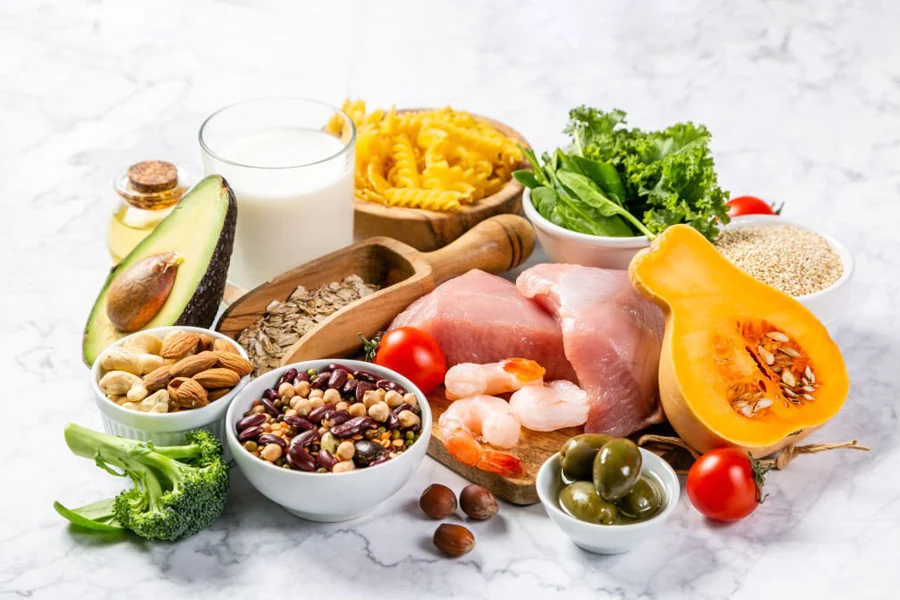The DASH stands for “Dietary Approach to Stop Hypertension”.
What is Dash Diet?
DASH diet eating plan is a diet rich in fruits, vegetables, rich in calcium, potassium, magnesium and fiber, low fat or non-fat dairy. It also includes mostly whole grains lean meat, fish and poultry, nuts and beans.
According to US National Institute of Health the DASH eating pattern promotes blood pressure reduction without medication. The DASH eating pattern has also proven to be beneficial for reduce the risk of many diseases, including some kinds of cancer, stoke, cholesterol, heart failure, kidney stones, and diabetes.
Limited sodium intake is the main goal in DASH diet. High sodium intake increases blood pressure, which in turn become a cause for cardiovascular diseases. Not more than 2,300 milligram (mg) per day of sodium intake is recommended in DASH diet and for better blood pressure control it should not more than 1,500 mg per day.
Dash Diet Foods

The DASH Diet places a strong emphasis on a variety of nutrient-rich foods, carefully balancing essential nutrients to promote heart health and overall well-being. Here are the main food groups emphasized in the DASH Diet, along with portion size recommendations:
| Food Group | Daily Serving size for 1600-3100 calories diet | Daily Serving size for 2000 calories diet | Example |
| Fruits | 6-12 | 4-5 | 1 medium piece of fruit, 1/4 cup dried fruit, 1/2 cup fresh, frozen, 6 oz fruit juice or canned fruit |
| Vegetables | 4-6 | 4-5 | 1 cup raw leafy vegetable, 1/2 cup cooked vegetable, 6 oz vegetable juice |
| Grains and Grains Products | 6-12 | 7-8 | 1 slice bread, 1 oz dry cereal,† 1/2 cup cooked rice, pasta, or cereal grain products |
| Lean Meat, Fish and Poultry | 1.5-2.5 | 2 or less | 3 oz cooked meats, poultry, or fish and fish. Note: Select only lean meats; trim away visible fat; broil, roast, or boil, instead of frying; remove skin from poultry Significance: Rich sources of protein and magnesium |
| Low fat or non-fat Dairy Foods | 2-4 | 2-3 | 8 oz milk, 1 cup yogurt, 1 1/2 oz cheese fat-free dairy |
| Nuts, Seeds and legumes | 3-6/week | 4-5/week | 1/3 cup or 1 1/2 oz nuts, 2 Tbsp or 1/2 oz seeds, 1/2 cup cooked and dry beans dry beans |
| Fats and Oils | 2-4 | Limited | 1 tsp soft margarine, 1 Tbsp lowfat mayonnaise, 2 Tbsp light salad dressing, 1 tsp vegetable oil |
| Sweets | <5/week | 5/week | 1 Tbsp sugar, 1 Tbsp jelly or jam, 1/2 oz jelly beans, 8 oz lemonade |
Note: These portion size recommendations are general guidelines. The DASH Diet can be adjusted to meet individual calorie and nutrient needs, and it allows for flexibility in food choices within each food group.
The Dash Diet Micronutrients Composition
The composition of macronutrient in DASH eating pattern are as follows:
• Total fat: 27% of calories
• Saturated fat: 6% of calories
• Protein: 18% of calories
• Carbohydrates: 55% of calories
• Cholesterol: 150 mg
• Sodium: 2,300 mg (A lower goal of 1,500 mg sodium was tested and found to be even better for lowering blood pressure, particularly for middle-aged and older individuals, African Americans, and those who already had high blood pressure.)
• Potassium: 4,700 mg
• Calcium: 1,250 mg
• Magnesium: 500 mg
• Fiber: 30 g
Health Benefits of DASH Diet
The DASH diet is not only beneficial for improving hypertension but also reduces the risk of adverse cardiac events, stroke, type 2 diabetes, cholesterol and obesity.
Hypertension
Hypertension is the major risk for cardiovascular and other fetal diseases. Around 65 million people are affected by hypertension. It causes about a million heart attacks and half a million strokes per year. People cannot feel the effects of high blood pressure, but it can impair life’s quality and end life prematurely.
The results of the Dash trials show that diet rich in fruits, vegetable, nuts, and low fat dairy products can significantly lower blood pressure. When the DASH diet is combined with a limited intake of sodium, the effects on blood pressure are greater still.
Cardiovascular Diseases
Elevated blood pressure is important cardiovascular risk factors and linked to the onset and progression of atherosclerosis. Dietary and lifestyle interventions are important behavioral strategies for cardiovascular risk reduction. The DASH dietary pattern is consistent with CV health dietary guidelines and includes a variety of micronutrients with beneficial benefits. Thus the heart-healthy dietary guidelines embrace these strategies in an overall diet to prevent and treat CHD. Thus in result prevents the risk of cardiovascular diseases (CVD).
Improved Cholesterol Levels:
In addition to lowering blood pressure, the DASH diet lowers total cholesterol and LDL cholesterol. The reductions in total cholesterol and LDL cholesterol are beneficial for maintain lipid profile. The fact is that DASH diet is rich in fruits, vegetables, and low-fat dairy products and is reduced in saturated and total fat which in improve the HDL cholesterol.
Weight Management
The DASH diet is also beneficial in weight control strategies. Here are some key aspects to control weight through DASH diet.
Balance and Portion Size Control:
The DASH diet’s foundation is built on balance to maintain healthy weight. DASH doesn’t rely on rigid portion restrictions but rather encourages mindful eating. By being conscious of what you eat and savoring each bite, you develop a healthier relationship with food, making it easier to manage portions and prevent overeating.
Cutting Back on Sodium
Reducing sodium intake is a core principle of the DASH diet, which helps prevent water retention and bloating, often mistaken for weight gain. Lowering sodium also promotes heart health, a bonus for those looking to shed pounds while safeguarding their cardiovascular system.
Lifestyle Changes
The DASH diet doesn’t stop at meal planning. It encourages a shift towards a healthier lifestyle, incorporating regular physical activity and stress management techniques. These factors complement your weight loss efforts, making them more effective and sustainable.
Better Blood Sugar Control
The DASH Diet’s emphasis on whole grains, fruits, and vegetables can help stabilize blood sugar levels, making it a valuable dietary approach for individuals with diabetes or those at risk of developing diabetes.
CONCLUSION
The DASH diet was originally developed to combat high blood pressure, but its remarkable benefits extend well beyond heart health. Its unique selling point for weight loss lies in its holistic approach. Unlike fad diets that promise quick results but often lead to disappointment, the DASH diet focuses on sustainable, long-term changes.
References
- Eilat-Adar, S, Sinai, T, Yosefy, C, et al. (2013) Nutritional recommendations for cardiovascular disease prevention. Nutrients 5, 3646–3683.CrossRefGoogle ScholarPubMed
- Hansson, GK (2005) Inflammation, atherosclerosis, and coronary artery disease. N Engl J Med 352, 1685–1695.CrossRefGoogle ScholarPubMed
- https://www.ahajournals.org/doi/full/10.1161/01.HYP.0000113046.83819.a2
- https://www.ncbi.nlm.nih.gov/books/NBK482514/
- https://www.sciencedirect.com/science/article/abs/pii/S0033062015300207

